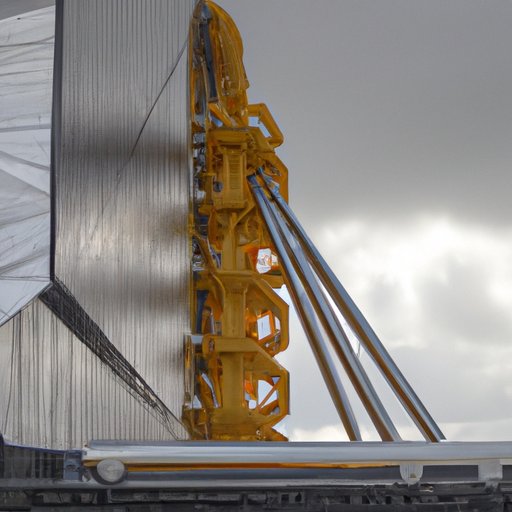
Overview of the James Webb Telescope and its Functionality
The James Webb Telescope is a revolutionary new space telescope set to launch in 2021 that promises to revolutionize astronomy by providing unprecedented resolution and detection capabilities. The telescope will be able to observe galaxies and stars, as well as planets and their atmospheres, allowing astronomers to make significant discoveries about our universe. In this article, we’ll explore how the James Webb Telescope works, from its basic design and technology to its unique capabilities and the impact it will have on astronomy.

Introduction to the James Webb Telescope
The James Webb Telescope (JWST) is a joint project between NASA, ESA, and the Canadian Space Agency. It is the successor to the Hubble Space Telescope, which has been in operation since 1990, and is designed to provide more powerful and advanced capabilities for astronomical observation. The JWST is a large and complex instrument, consisting of a 6.5-meter primary mirror, four scientific instruments, and a deployable tower system. It will be launched into a halo orbit around the second Lagrange point of the sun-Earth system, 1.5 million kilometers from Earth.
What the James Webb Telescope Can Do
The James Webb Telescope is designed to observe the universe in infrared light, allowing it to detect objects that are too faint or distant to be seen with visible light. This will give it the ability to observe galaxies and stars in the early universe, as well as planets and their atmospheres in other solar systems. The telescope will also be able to observe phenomena such as supernovae, black holes, and dark matter. With its unprecedented resolution, the JWST will provide a detailed look at the structure of our universe and the evolution of galaxies, stars, and planets.
The Basic Design and Technology Behind the Telescope
The James Webb Telescope is made up of several components, including the optics and instruments, the spacecraft bus, the sunshield, and the deployable tower system. The optics and instruments consist of a 6.5-meter primary mirror and four scientific instruments, which will be used to collect and analyze data from the telescope. The spacecraft bus is the main body of the telescope, which houses the electronics and other systems, and provides power and communications to the other components. The sunshield is an enormous five-layer membrane that wraps around the telescope, keeping it cool enough to operate. Finally, the deployable tower system consists of four articulated arms that hold the sunshield in place, allowing the telescope to rotate and point at different targets.

Exploring the Science Behind the Design of the James Webb Telescope
At the heart of the James Webb Telescope’s design is physics and optics. The telescope’s primary mirror is made up of 18 hexagonal segments, each measuring 1.3 meters across. These segments are arranged in a honeycomb pattern and coated with a reflective material, allowing them to capture and focus light from distant objects. The telescope also contains four scientific instruments, which will be used to collect and analyze the data from the telescope. These instruments include the Near Infrared Camera (NIRCam), the Near Infrared Spectrograph (NIRSpec), the Mid Infrared Instrument (MIRI), and the Fine Guidance Sensor (FGS).

Examining the Technology that Makes the James Webb Telescope Work
In addition to the optics and instruments, the James Webb Telescope is powered by a number of technologies that allow it to operate in space. The spacecraft bus is the main body of the telescope, which houses the electronics and other systems, and provides power and communications to the other components. The sunshield is an enormous five-layer membrane that wraps around the telescope, keeping it cool enough to operate. Finally, the deployable tower system consists of four articulated arms that hold the sunshield in place, allowing the telescope to rotate and point at different targets.
How the James Webb Telescope will Revolutionize Astronomy
The James Webb Telescope is set to revolutionize astronomy by providing unprecedented resolution and detection capabilities. The telescope’s unique capabilities include the ability to observe galaxies and stars in the early universe, as well as planets and their atmospheres in other solar systems. With its unprecedented resolution, the JWST will provide a detailed look at the structure of our universe and the evolution of galaxies, stars, and planets.
Discovering What the James Webb Telescope Can See
The James Webb Telescope will be able to observe galaxies and stars in the early universe, as well as planets and their atmospheres in other solar systems. It will also be able to observe phenomena such as supernovae, black holes, and dark matter. With its unprecedented resolution, the JWST will provide a detailed look at the structure of our universe and the evolution of galaxies, stars, and planets.
A Look at Future Missions with the James Webb Telescope
The James Webb Telescope will enable a variety of future missions and applications, such as searching for signs of life on exoplanets, studying star formation, and exploring the history of the universe. It will also be used to study dark matter and dark energy, which are believed to make up most of the universe. Additionally, the telescope will be used to search for asteroids and comets that could potentially threaten Earth, and to study the effects of climate change on our planet and beyond.
Conclusion
The James Webb Telescope is a revolutionary new space telescope that promises to revolutionize astronomy by providing unprecedented resolution and detection capabilities. It will be able to observe galaxies and stars in the early universe, as well as planets and their atmospheres in other solar systems. With its unique capabilities and unprecedented resolution, the JWST will open up a world of possibilities for astronomers, enabling them to make significant discoveries about our universe.
(Note: Is this article not meeting your expectations? Do you have knowledge or insights to share? Unlock new opportunities and expand your reach by joining our authors team. Click Registration to join us and share your expertise with our readers.)
